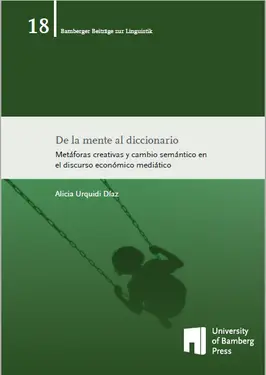Doctorate in Spanish Linguistics
De la mente al diccionario: Innovación con metáforas y cambio semántico en el discurso económico mediático.
Defended in Bamberg, on July 25th, 2017.
Thesis available as full text on the University of Bamberg OPUS server.
The purpose of this study is to examine the cognitive processes, the semantic-conceptual products and the discursive functions of creative metaphors. These functions are understood as a modality of creativity in language-in-use that has the potential to become conventionalized in the language system. Based upon an analysis of metaphorical expressions in a specific social and communicative context (economics news reporting), this study integrates insights from cognitive semantic theory, historical lexicology and pragmatics into a coherent description of mental processes that generate creative utterances. These utterances contain conventional elements, and are crafted in accordance with a Speaker/Writer's functional and communicative intention. Given certain conditions, the Addressee/Reader will replicate and introduce these expressions into their own repertoire of conventional expressions. In time, these expressions will become lexicalized and form a part of the language system.
To achieve the purpose of this study, we examine the relationship between creativity and conventionality, both in language as a whole and in Spanish in particular. The studied creative utterances (over 3.000 collocations from various online newspapers from Chile and Spain) were annotated with two varieties of tags: type of conceptual structure, and one or more source domains (tenor). Regarding the first variety, this study describes the conceptual structures underlying the expressions, paying special attention to interactions between conventional and creative conceptual contents. Both types of content integrate (blend) in order to create familiar, but original, expressions (Fauconnier and Turner, 2003; Brandt and Brandt, 2005). These descriptions highlight the metonymical and metaphorical sub-processes involved in conceptual blending, which work together to generate figurative products that can be interpreted as metaphors or metonymies. Some of these processes, including metaphtonymy (the interaction of metaphor and metonymy), the double and generic interfaces, as well as mixed metaphors, are described in depth and elaborated alongside examples and schematic representations.
Regarding the second set of tags, the semantic/conceptual content and socio-historic context of selected utterances is provided. Context is crucial to the understanding of the functions these figurative expressions may perform in the text, discourse, and, if successful, in readers’ minds. The language of economics is ever-present in modern Western society, and may be considered constitutive of some of its main tenets in a way some other domain-specific languages, such as cooking or sports, cannot. Indeed, this study identifies ideological and counterideological metaphors, which represent discursive strategies that give shape to public discourse and debates. It has been well established that conventional metaphors and metonymies provide an ideological advantage to the Speaker/Writer; notwithstanding, this study shows that it is also possible for an Addressee/Reader to respond to covert — or “sleeping” — metaphors by “reawakening” or reactivating them in order to question and challenge their hidden ideological bias. Although social factors make it nearly impossible to predict which metaphors or conceptualizations will prevail, or even if they will do so to the exclusion of competing concepts, this study lays out criteria to evaluate an utterance’s potential for conventionalization. These criteria may be lexicological (e.g. semasiological salience) or sociopragmatic (e.g. onomasiological salience or connotations).
